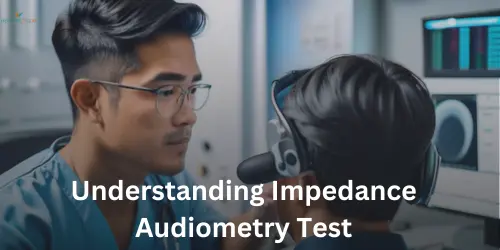
Understanding Impedance Audiometry Test: A Comprehensive Guide
Mobility of sounds and impacts on the overall health of one’s auditory system is assessed in a series of tests known as (diagnostic audiometry). Impedance audiometry is one of a few tests that, in this series, can be considered to be crucial. The article presents a detailed overview of impedance audiometry and why it is done, its advantages and its editions. This guide aims to educate the reader about doing this important audiological evaluation. It presents the complete picture of how it is done, what are the indications of it and why it is so important in the field of hearing health.
What Is an Impedance Audiometry Test?
Impedance audiometry is also known as tympanometry in certain geographies. It is a safe method of diagnosing the middle ear that does not involve any invasiveness.
It assesses the conformity of the tympanic membrane (eardrum) to mobility when the air pressure is in its variable state. This is used in measurement where fluid accumulation or eustachian tube blockage, otitis media and other middle ear disease conditions for example. With the helpful information that impedance audiometry provides in assessing the active middle ear, answers regarding the causes of different hearing disorders are found and appropriate therapies are given.
Purpose of Impedance Audiometry
There are two major sections of the impedance metric audiometry purpose which include the following:
The initial one concerns the pathology diagnosis of the middle ear: with the help of this test, it is possible to determine whether there is any fluid in the middle ear, which is a common complication associated with otitis media.
Monitoring Middle Ear Conditions: It checks up on various numbers of middle ear conditions’ responses to treatment. Therefore, through impedance audiometry, contributions are made to the holistic evaluation of hearing health.
How is the Impedance Audiometry Test usually done?
The whole process of impedance audiometry is easy and quick and takes less than five minutes to perform even for first-time patients. Below are some of the details about how this test is done so that audiologists get the right outcomes. Such knowledge is beneficial to the patients since it makes them understand the importance of the test is as well as helps them know what will take place in the actual treatment session thus relieving any anxiety that the unknown could have caused.
Preparation
- Patient History: During the assessment, the audiologist will ask a range of questions to obtain the patient’s medical history related to ear symptoms or illness.
- Visual Examination: This will be done right before the test, with the use of an otoscope, the audiologist will examine the eardrum and the ear canal for any blockages or infections.
This initial assessment assists in recognizing any problems that might compromise the objective of the impedance audiometry test.
Procedure
- Insertion of the Probe: An otoscope is a small device that is placed into the ace to measure the eardrum. The probe is made up of three components, that are spiral, microphone and a pressure pump.
- Achieving Pressure: A continuous tone is played by the speaker as the pressure pump changes the pressure within the ear canal.
- Measurement: The microphone picks up the sound that bounces back off the tympanic membrane. The amount of sound bounced back is also an indication of the tympanic membrane mobility.
- Graph Generation: The tympanogram graph plots the eardrum’s movement towards the pressure given and the movement withdrawals. This graph is then stripped off to explain the health of the middle ear structure.
Interpretation of Results
The tympanogram is classified systematically from type 1 to type 4 according to the respective tympanogram generations:
- Type A: refers to a tympanogram which is consistent with the normal functioning of the middle ear.
- Type B: Indicates are consistent with the presence of fluid in the middle ear and tympanic membrane perforation.
- Type C: tympanograms indicate the presence of negative pressure in the middle ear which is most likely due to dysfunction of the eustachian tube.
Advantages of Impedance Audiometry
Impedance audiometry is helpful in the assessment of the middle ear condition because it is
- Noninvasive: The process is pain-free and, thus suitable for all ages, from infants to young children
- Quick Procedure: It is a short time-consuming procedure that is finished in a few minutes and is followed by immediate diagnosis and treatment
- Precise Diagnosis: It provides details about the functioning middle ear in the form of good acoustic impedance which is useful in accurate diagnosis.
- Monitoring Treatment: The test is useful in establishing whether treatment for middle-ear disorders is effective. verifying proper care. These benefits highlight the significance of impedance audiometry in ensuring the best hearing health.
Common Conditions Diagnosed by Impedance Audiometry
Impedance audiometry is very essential in diagnosing several middle ear conditions. These include;
Otitis Media
Otitis media, or middle ear infection is a common ailment, especially in children. Fluid in the middle ear represents one of the hallmark characteristics of otitis media, and impedance audiometry can detect this fluid condition. Early intervention reduces the chances of complications and ensures better outcomes for ear health.
Eustachian Tube Dysfunction
Hence, the eustachian tube must keep the balance pressure within the middle ear. Improper functioning of this tube might cause a negative pressure in the middle ear, which can be detected by the impedance audiometry. Recognition of these problems at the early stages may prevent them from turning into chronic conditions of ears with their related symptoms, including the feeling of the ear being uncomfortable and creating a sense of loss of hearing.
Ruptured Trompanic membranes
A ruptured ear drum may occur due to infections, violence, or sharp changes in architecture. Impedance audiometry helps in determining the presence and the degree of eardrum perforation. This data is essential in finding out the suitable procedure to take for the patient and dealing with any deafness associated with the rupture.
Cholesteatoma
A cholesteatoma is an abnormal growth of skin cells in the middle ear cavity that leads to issues such as hearing loss. Impedance audiometry is helpful in cholesteatoma management for detection and follow-up. For avoiding adverse outcomes and treatment management timely diagnosis is of utmost importance.
Who Should Undergo an Impedance Audiometry Test?
Impedance audiometry should be carried out on anyone who is experiencing symptoms associated with the middle ear. Some of the symptoms and situations for performing this test include;
- Hearing Loss: Any case of unexplained hearing loss should be investigated using impedance audiometry, especially if there are suspected middle ear problems.
- Ear Pain: Persistent pain in the ear may be a symptom of an undefined condition in the middle ear that needs investigation.
- Tinnitus: Tinnitus or ringing in the ears may suggest a middle ear disorder
- Balance Problems: The middle ear has auricular and vestibular functions that serve to maintain balance. An abnormality can present as dizziness or a balance disorder
- Ear Infections, Recurrent: Since recurrent ear infections in children would justify an impedance audiometry test for proper management, finding the problem could be one of the factors that contribute to successful treatment.
Proper preparation before sitting for the test ensures the accuracy of results. Here are some preparation tips:
- Avoid Loud Noises: Avoid exposure to loud noises before the test since it may affect the results.
- Stay Still: During the test, it is important to remain still and also avoid talking or swallowing to ensure precise measurements.
- Inform the Audiologist: Inform the audiologist of any ear symptoms or any drugs you take. Proper preparation helps you undergo a smooth testing process and yield more reliable results.
Limitations and Considerations
Although impedance audiometry is one of the modern tools available for clinical audiology, it comes with some limitations and considerations:
- Limited Scope: This test assesses the middle ear, and inner ear auditory nerve disorders cannot be evaluated using this test.
- Not a Standalone Test: Impedance audiometry is normally carried out alongside other audiological tests to arrive at complete hearing health.
- Patient Cooperation: This test requires that the patient be able to remain still and follow verbal instructions accurately to produce reliable results These characteristics emphasise the significance of a comprehensive approach in audiological examinations.
Advances in Impedance Audiometry
Over time, the field of audiology, especially impedance audiometry, has undergone rapid technological advancements. Currently, devices are more accurate, easier to handle and have finer outputs. This has also helped improve the diagnosis and management of middle ear diseases indicating the progress that has been made in the techniques of audiological assessment.
Automated Systems
Manual intervention in acoustic impedance measurement is not necessary to a great extent due to the introduction of automated impedance audiometry systems which have simplified the testing process. These systems are generally fast and reliable, which makes them suitable in clinical settings that are mostly busy. Enhancing the process by making it automatic means that, consistency and accuracy are enhanced leading to an overall improvement in minutes of assessment activities.
Integration with Other Tests
With the help of modernisation, improvement in technology has made it possible to combine impedance audiometry with other audiological tests such as otoacoustic emissions (OAE) and pure-tone audiometry. This type of methodology aids in the hearing health evaluation. The use of several tests enables a better diagnosis and promotes the formulation of appropriate treatment strategies.
Conclusion
Impedance audiometry is an important tool that assists audiologists in understanding the condition of the middle ear. The eardrum’s movement response to changes in air pressure is measured in this test to help evaluate and track the course of several pathologies of the middle ear. The method of impedance audiometry in evaluating hearing health is ego-below indispensable due to its up-to-date non-invasive methods, quick implementation of the procedure, and the accuracy of the results achieved. Knowing the benefits and the principles of functioning of the impedance audiometry test is significant for healthcare providers and patients who seek to promote ear care. Impedance audiometry is also a vital aspect of the management and diagnosis of patients seeking a hearing assessment in a BERA Test or hearing test in Delhi.
When a subject has hearing impairment, earache, tinnitus, or balance disorders, impedance audiometry provides a suitable evaluation. It is expected that with improving methods and availability of instrumentation, the test will gain wider application within the scope of audiological assessment our ability to treat the disorders of the middle ear would also substantially improve. The developments in impedance audiometry are important and guarantee that even today it is one of the basic audiological examinations.
Frequently Asked Questions
Impedance audiometry test is an assessment used to assess the middle ear patency. The test is valuable for the diagnosis of the following conditions: Otitis media (Middle ear fluid infection) Perforation (hole or rupture) of the tympanic membrane.
Normal values range from 0.3 to 1.3 cm3, and abnormal values indicate pathology of the middle ear. Changes in resistance of the conductive system caused by increasing acoustic pressure in the external ear canal are graphically presented as a tympanogram.
Impedance tests are now being used to diagnose a range of gastrointestinal disorders, primarily in the oesophagus.
Normal shock impedance is around 20–100 Ω, while the normal pacing impedance is typically between 300–1000 Ω.
At this point, when you get to more complex signals, AC impedance is a more useful measurement because it also conveys some information about frequency. In simple terms, impedance allows you to measure resistance at a particular frequency.
Dr. Harshi, is an accomplished Audiologist with extensive expertise in treating individuals with hearing impairments.

